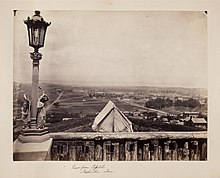Tennessee State Capitol
The Tennessee State Capitol is modeled after an Ionic temple, incorporating Greek Revival architecture, and is composed of limestone quarried from nearby.
On top of the roof is a 42 ft (13 m) tall round tower, modeled after the Choragic Monument of Lysicrates, that sits on a square pedestal-like structure.
[3] On October 7, 1843, the Tennessee General Assembly declared Nashville as the state's permanent capital, and planning for a statehouse began shortly thereafter.
[8] The State Capitol was designed by renowned Philadelphia architect William Strickland, who modeled it after a Greek Ionic temple.
The prominent lantern structure located above the roof line of the Tennessee state capitol is a design based upon the Choragic Monument of Lysicrates in Athens that honors the Greek god Dionysus doing battle with Tyrrhenian pirates.
[9] The cornerstone of the Tennessee state capitol was itself laid on July 4, 1845 and the building was completed fourteen years later in 1859.
Some interior columns were built from single pieces of stone, requiring massive wooden derricks to hoist them into place.
Fifteen enslaved Black men worked on carving the Capitol's limestone cellar from 1845 to 1847; Nashville stonemason A.G. Payne was paid $18 a month for their labor.
On May 30, 2020, the Sen. Edward Ward Carmack Memorial located above the Motlow Tunnel near the south entrance was toppled by protestors during a demonstration in response to the police murder of George Floyd.
[16] During the Nashville Autonomous Zone the area near where the statue stood has been unofficially claimed by protesters as "Ida B.
This bust resulted from legislation introduced by Democratic state senator and Sons of Confederate Veterans member Douglas Henry in 1973, and its presence was controversial since its dedication.


